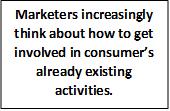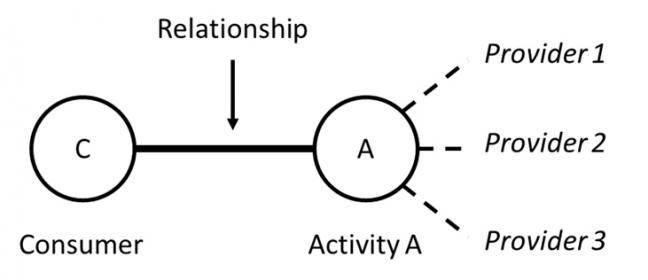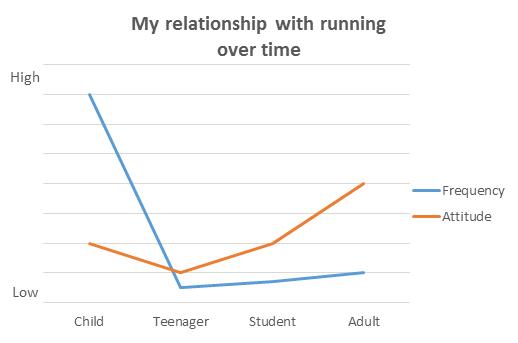In our everyday lives we all have activities that we love or hate to do: Cleaning our homes, playing tennis or commuting to work. Thus, we might say that we have ongoing relationships with these activities. However, traditionally marketers have not thought in these terms. Rather, they have often understood consumer’s activities in terms of responses. Advertisers send us marketing messages, and then hope that we respond by buying their product. Sometimes marketers also see us consumers as collaborators who contribute by the activities we perform. For example, customers can clean away their own trash at the fast food restaurant. Thus, one of the core questions in marketing has traditionally been: “how can we make people do things?”
However, marketers are increasingly thinking about how to get more involved in activities that already happen within consumers’ everyday lives. Consider the sports tracker. This device allows companies to get directly involved in supporting the everyday activity of running. Thus, the question of “how can we make people do things?” is becoming supplemented with the additional questions of “how can we do things with people?”, or even, “how can we participate in what people do?” Indeed, the increasing digitalization of our lives has made thinking about consumer activities more important in general for companies. Most of us carry digital devices with us every moment of our everyday lives, and so companies can use these devices as a gateway to support our everyday activities.

Because of this, it has become increasingly relevant to understand how we, as consumers relate to our own activities. How do we, in fact, feel about the activity of running, shopping or eating fast food? Some hate shopping and get anxious after ten minutes. Others have made the act of eating fast food into a weekly family ritual. In consumer research, consumers’ attitudes about their everyday lives and activities have of course already been the object of study for a very long time. However, they have typically not considered the problem in terms of a relationship between the consumer and an activity. Why would such an approach be useful, and what does it mean?
Consumer’s relationships with activities
The relationship approach is useful, because it allows marketers to think about the company’s role in the customer’s life in a straightforward manner: We are not primarily selling services, products, brands or even customer experiences, but rather, we are supporting or enabling an activity. Figure 1 illustrates this idea, showing the relationship between a particular consumer and an activity. The providers on the right-hand side are involved in enabling or supporting the activity (e.g. running or cleaning your house) and the line in the middle represents the strength of the consumer’s relationship with this activity.

If the relationship is strong, the providers on have a good chance to find a way to contribute to this activity. If the relationship is weak, the providers are in a precarious situation, and might risk losing the customer. Thus, providers need to understand the nature of the relationship in order to support or strengthen it.
Figure 1: The relationship between a consumer and an activity
So if the relationships between consumers and activities are so important, what do these relationships consist of? In my recent paper I argue that ideas from traditional relationship marketing (i.e. business relationships) can be applied to explain the relationship between consumers and their activities. For example, in the relationship marketing tradition, the strength of customer relationships has been explained in terms of a combination of customer’s attitudes and frequency of patronage. What happens if we apply this model onto relationships with activities?
Let’s take an example from my own life. Figure 2 shows the development of my relationship with the activity of running: The blue line shows how often I have done the activity, and the orange one how my attitude towards running has changed. As a child, I ran every day, more or less. As a t eenager, this frequency dropped and has not really recovered. Conversely, my attitude has improved over time, so I would like to run more than I actually do. Why does this matter?
eenager, this frequency dropped and has not really recovered. Conversely, my attitude has improved over time, so I would like to run more than I actually do. Why does this matter?
This approach helps companies to understand the different relationships consumers have with their activities, and to figure out how to support the consumer under different stages of the relationship. The consumer will need different types of support in the beginning of the relationship than they do in the middle or end of it.
Figure 2: My relationship with running

Thus, the approach highlights the consumer’s perspective. In my paper I argue that people can have deep, passionate or conflicted relationships with their activities. The relationships fulfill many of the criteria of human-to-human relationships. For example, people might have different types of feelings about the activity and they might consider themselves to be in a long-term relationship with it. They may even think about the activity as having a certain personality! Thus, it makes sense for businesses to start considering how to take such relationships into account. What are their customers’ long-term relationships with important activities? How can customers be assisted in initiating, improving or terminating their involvement in activities? As such, the research serves as an opening to asking many new types of marketing questions.
The paper is available at the following address:
http://www.emeraldinsight.com/doi/abs/10.1108/JSM-03-2016-0108
Affiliated Researcher
